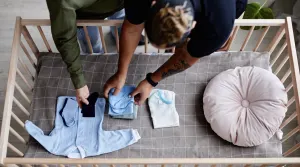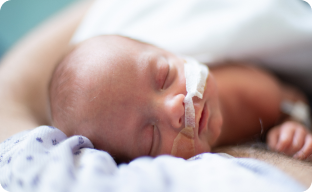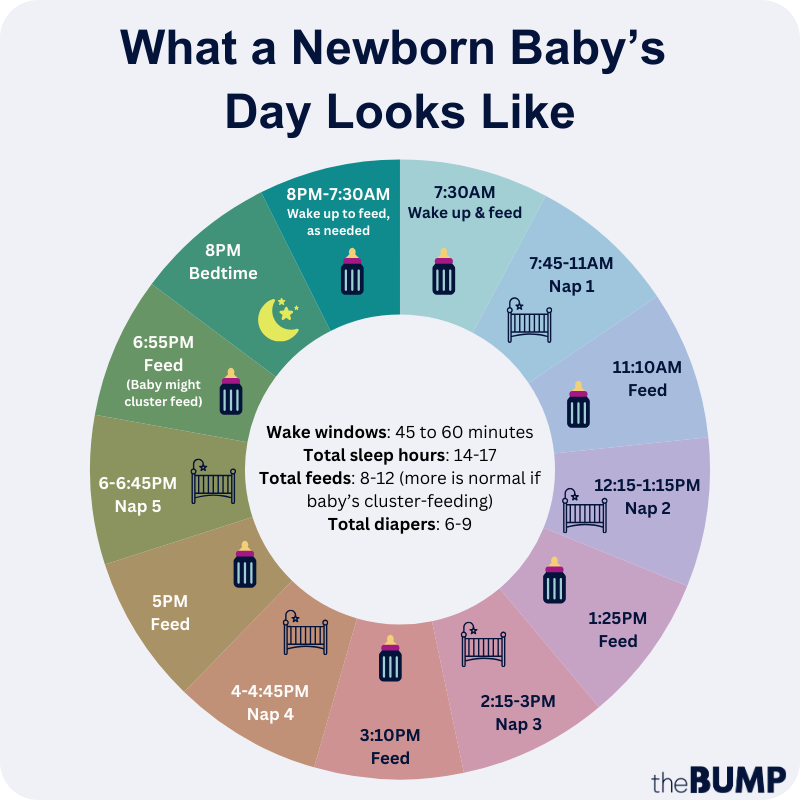Newborn Baby

Congratulations on your new baby! Now it's time to figure out parenthood: the feeding, the bathing, the diaper-changing and, oh… the sleeping! Don’t worry too much (easier said than done, we know): You'll get the hang of everything in time. Just don't freak out if adjusting to this new life doesn't "come naturally"—it can take a little longer for some than others. These first few weeks with your newborn are about resting, recovering and getting to know baby, as you and your partner figure out how to navigate life with this amazing new addition to your family! Ahead, learn everything you need to know about your newborn baby, including newborn milestones and development, key health tips and advice from seasoned parents.
- Don’t worry about a newborn baby schedule yet: A newborn typically has their days and nights confused. With a little nudge here and there, they’ll adjust soon enough.
- Newborn won’t stop crying? Newborn crying is very normal—but if it lasts for an unusually long time, ask your pediatrician whether it could be colic. (Colic typically involves crying that lasts three or more hours a day on three or more days a week.) The good news is, colic usually improves by the time baby is 3 or 4 months old.
- Cluster-feeding is also very normal, so don’t panic if your newborn baby wants to feed every half an hour—especially in the evening.
The average weight for a baby at birth is 7.1 pounds for girls and 7.4 pounds for boys. The average length is 19.3 inches for girls and 19.6 inches for boys, according to the World Health Organization. But baby’s growing fast! Don’t be surprised if you notice lots of growth spurts](https://www.thebump.com/a/baby-growth-spurts)—and—and) cluster feeding—during baby’s early weeks on the planet.
Worried about newborn weight loss after birth? Don’t get nervous about a dip in the scales. It’s normal for baby to lose up to 10 percent of their birth weight in the first week of life, depending on whether they’re breast- or formula-fed—they’re just shedding the extra fluids they had at birth. Baby should return to their birthweight by the end of their second week. Be sure to follow up with your pediatrician to make sure baby’s tracking along their growth curve.
While your newborn baby’s still tiny, there are still a few milestones on the horizon:
- At some point during baby’s first two or three weeks, their umbilical cord will fall off. After that, baby will be ready for their first real bath (rather than a sponge bath).
- Baby’s working on turning their head from side to side, and by 1 month old, they may even start to lift their head for a second while you practice tummy time. (Speaking of which, it’s a good idea to put baby on their tummy a couple of times a day, a few minutes at a time—more on that later!)
- Baby’s keeping their hands in fists. By the one-month mark, they’ll be able to raise them toward their face. They’ll also be able to grasp their fists tightly.
Newborn sensory development
- Vision. Baby’s eyesight might still be a little blurry. As baby tries to focus, you may notice their eyes looking crossed. That’s totally normal for this age—as long as both eyes are moving (one doesn’t seem like it’s stuck) and there aren’t any windshield-wiper-like eye motions. Baby’s eyes should look much straighter by the time they're 4 to 6 months old. (If not, talk to their doctor.)
- Hearing. A newborn can hear, but they don’t yet understand what the sounds mean. By the time they’re 1 month old, baby will start to recognize familiar sounds—like your voice—and might show it by turning their head.
- Smell. Fun fact: Baby may now recognize your specific smell.
Newborn reflexes
Baby was born with quite a few newborn reflexes (some of which are very cute, if you can’t already tell.) Your pediatrician will check for these during your appointments. At the newborn stage, reflexes include:
- Rooting reflex. Stroke or touch the corner of baby’s mouth, and they’ll turn their head and open their mouth to follow. This helps them find the breast or bottle to start feeding. The rooting reflex lasts until about 4 months of age. Rooting helps prepare baby for sucking.
- Sucking reflex. When you touch the roof of baby’s mouth, they’ll start to suck.
- Moro reflex. Also known as the startle reflex, it usually happens when baby is startled by a loud sound or movement. In response, they’ll throw back their head, extend their limbs, pull them back in and then cry. This reflex lasts until baby is about 2 months old.
- Palmar grasp reflex. Baby will close their hand around yours in a grasp when you stroke their palm (or close their hand around an object). This lasts until they’re about 5 to 6 months old.
Most newborn reflexes will go away by the time baby is 6 months old.
“The many months of growing in a warm and wet place can cause newborns to look swollen or puffy from the extra fluid, or have wrinkly or peeling skin, similar to when you spend too long in a bathtub.” — Ansley Schulte, MD, pediatric medical director at KidsPeace
All of a sudden, you’re tasked with taking care of a whole human! Naturally, you have a lot of questions about their health. Here are a few basics to get you started:
Crying and colic
It’s normal for a newborn to cry—anywhere from one to four hours a day, in fact!—for a huge range of reasons. But if baby cries all the time, you might be wondering whether it’s colic. Colic can involve crying that lasts for three or more hours a day on three or more days a week, often around the same time. (Take heart: It typically gets better by the time baby is 3 to 4 months old.) If you’re at all worried, it’s a good idea to check in with your pediatrician.
Umbilical cord care
In the womb, the umbilical cord connected baby to you and helped deliver important nutrients to them. But after your doctor cuts the cord during delivery, it dries up, shrivels and eventually falls off (within about two or three weeks of delivery). In the meantime, all you need to do to care for baby’s umbilical cord is keep it clean. You’ll also want to fold your little one’s diaper below the cord stump to help avoid irritation and keep urine away from it. Keep in mind that a few drops of blood when it falls off is normal, but if the area is actually bleeding or looks infected, call your pediatrician.
Jaundice
Jaundice in babies happens when a chemical called bilirubin builds up in a newborn’s blood, which causes baby’s skin to turn yellow. If your little one has jaundice, your doctor will measure their bilirubin level with a skin or blood test before baby is discharged from the hospital. Light therapy is a common and effective jaundice treatment, although mild cases may not need treatment at all.
Puffy genitals
Puffy genitals are common in newborns, and it’s often due to excess fluid. The amniotic fluid that baby has been surrounded by during pregnancy can move to different parts of the body, causing swelling and puffiness all over the body, including the genitals. As baby adjusts to life outside the womb, the swelling will naturally go down and they’ll pee out any extra fluid they retained from the womb.
Head shape
Don’t panic if baby has an uneven head shape for a while: This is pretty normal for babies born through vaginal delivery, and it rounds out over time. Babies are born with soft spots on their heads called fontanelles, which let them move through the narrow birth canal. But baby’s head shape can also change due to lying on their back for too long (the safest sleeping position for baby); this is called positional plagiocephaly. If you’re concerned, talk to your pediatrician, who might prescribe extra tummy time or helmet therapy depending on the severity of the condition.
Newborn poop
Baby’s first poop is called meconium, which is usually dark green and sticky. After that, your little one will develop their own unique pooping patterns. Every baby is different, but talk to your pediatrician if baby’s poop is hard and pebbly, red, black, white, gray or clay-colored. Also be sure to check in if your breastfed baby hasn’t pooped in over three days or your formula-fed baby hasn’t pooped in over five days.
Checkup and vaccines
Well-visits are a way for your pediatrician to keep an eye on baby’s growth, development and overall health. Your newborn will usually see the pediatrician for their first checkup sometime between the three- and five-day mark, and again at 1 month old. During these visits, the doctor will examine baby and give them vaccines on a schedule recommended by the American Academy of Pediatrics (AAP). Baby has likely received the hepatitis B vaccine within 24 hours after birth, and the RSV vaccine within a week of birth, if it’s RSV season. If you have any questions, ask baby’s pediatrician.
Don’t be surprised if your newborn baby seems insatiable! Typically, a breastfed baby will nurse about 8 to 12 times during a 24-hour period. But if you’re breastfeeding, baby might also cluster feed, aka feed really often—especially if they’re going through a growth spurt. We know it’s hard, but don’t watch the clock while breastfeeding! First, offer baby one breast, and make sure they're latched on well. If they still seem hungry after that breast is soft, offer the other one. Baby will stop when they're full.
If you’re formula-feeding, it’s also important to follow baby’s cues. At 1 week old, 1 to 2 ounces of formula every two to three hours should be about right. By 4 weeks, you can try feeding about 4 ounces every four hours.
Pay attention to baby—they’ll communicate with you when they're hungry (crying, lip smacking, “rooting” or turning their head in search for a nipple), and they’ll stop eating when they feel satisfied. If you’re worried baby’s not drinking enough breast milk or formula, keep an eye on how many diapers they’re filling: You should need at least six to nine diapers in a 24-hour period. (Yes, it gets expensive: Start a subscription to your favorite diaper brand now to get discounts.)
The number-one thing to know about newborn sleep is that many babies get what’s called “day-night confusion.” Don’t worry—this is perfectly normal and your little one will get the hang of things soon enough. Also important to keep in mind: Night wakeups are completely normal—baby’s tummy is tiny and they need to feed—so don’t be surprised if they wake up every couple of hours during the night (but do make sure you have a plan and a support system in place, if possible). Newborns typically sleep about 16 hours per day (lucky them!), with eight to nine of those hours clocking in at night.
Last but not least, always put baby to sleep on their back, and make sure the crib is free of soft or fluffy bedding and other objects, to reduce the risk of Sudden Infant Death Syndrome (SIDS).
While it’s pretty impossible to put a newborn on a true schedule, you can try to create patterns throughout baby’s day for some predictability. A common routine for a newborn baby is eat, play, sleep, repeat. That said, here’s a sample of what your newborn’s day might look like—keeping in mind that every baby is different!
Parenting a newborn can seem like running a never-ending marathon. Don’t neglect yourself while taking care of baby—you’re likely going through lots of physical changes yourself. Here are a few things to expect.
Postpartum recovery for vaginal birth
While everyone’s recovery is different, doctors say that it typically takes about six weeks to fully heal after a vaginal delivery. In the meantime, you can expect to have vaginal bleeding and discharge called lochia. (Make sure you’ve stocked up on those free pads at the hospital!) It’s also normal to have uterine contractions or cramps in the first few days after delivery; you can take ibuprofen or another pain reliever for these. To soothe pain, swelling and irritation, try taking a sitz bath a few times a day. Also, you can make some cooling “padsicles”: We have easy instructions here. If your pains are particularly bad or the bleeding is heavy or increases, check in with your doctor.
Postpartum recovery for a C-section
When healing after a C-section, it’s best to take it slow. You might be anxious to get back on your feet, but it’ll take some time. Move gently and avoid heavy lifting for six weeks—or until you get the go-ahead from your provider. Your doctor might also tell you to avoid driving or taking stairs for a while. During your C-section recovery, you’ll likely experience bleeding and discharge called lochia from your vagina for up to six weeks. Your incision scar will be slightly raised and more pink than the rest of your skin at first, and it may look puffy. If you’re experiencing pain, it should decrease after two or three days; you can take a pain relief medicine in the meantime. Keep in mind that your healing incision might feel sensitive for three weeks or more. Over time, your scar will become thinner or flatter. If the pain becomes worse or your incision looks infected, reach out to your doctor.
Your postpartum timeline
Wondering what you can and can’t do after birth? Within about two weeks, you’ll likely be able to take a full bath, drive and perform light exercise. But you’ll probably have to wait until six weeks after to have sex, wear a tampon and do more strenuous exercises. Check in with your provider, as (again!) everyone’s recovery is different.
Postpartum breast engorgement
In the first week after giving birth, your breasts might feel swollen and painful. This is called postpartum breast engorgement and it’s completely normal—your milk is coming in so you can feed baby. Remember: Pumping a lot of milk will likely only make engorgement worse, but you can help prevent it by feeding baby and/or pumping at the frequency baby needs. Applying cold packs to your breasts can help reduce inflammation, as can taking a pain reliever. A lactation consultant can guide you on how to apply gentle pressure to the area to relieve engorgement; you can also ask your provider if they can do manual lymphatic drainage to improve lymph flow in your breasts.
Postpartum mental health
Becoming a new parent is a huge adjustment. It’s natural for post-pregnancy hormones to contribute to mood swings, and sometimes more serious mental health issues. It’s important to give yourself grace and realize that you’re managing a lot, especially if you had a complicated pregnancy and delivery. Stay in close touch with people who matter to you, and don’t be afraid to ask for help. Read up on the symptoms of postpartum depression, anxiety and OCD, and be sure to contact your provider if you think what you’re experiencing goes beyond the typical “baby blues” phase.
Newborn baby care tips
Yes, it’s a lot. But you can do it! Here are a few key points to remember when caring for a newborn baby:
- Dressing a newborn. Your little one will need several layers to stay warm. In general, it’s best to dress baby in one more layer of clothing than you have on to be comfortable. You can dress baby in a onesie or shirt and diaper, followed by pajamas or a night gown, and then wrap baby in a receiving blanket. In hot weather, you can have baby wear a single layer.
- Skin-to-skin contact. Skin-to-skin, aka kangaroo care, involves cuddling with baby’s bare skin against yours. Many birthing centers and hospitals recommend doing this after birth. Skin-to-skin care can promote bonding and causes the release of feel-good hormones for you and baby. It can also help regulate baby’s body temperature and heart rate.
- Nail care and growth. Baby nails grow quickly, and you may need to trim them once a month. It’s important to keep them clean and trimmed to keep your little one from injuring themselves or others. To care for baby’s nails, clean their hands and use a nail file to shorten and smooth the nails. Make sure to use baby-sized nail clippers.
- Sponge baths. It’s recommended to delay baby’s first bath until at least 24 hours after birth. After that, you can bathe them about three times a week. (More than that may dry out baby’s skin.) Only give baby a sponge bath until the stump of the umbilical cord falls off. During the sponge bath, lay baby on a flat, comfortable surface, like a changing table or blanket on the floor. Use a damp cloth to wash baby’s face, and then wash the rest of their body and the diaper area. Keep baby wrapped in a dry towel and only uncover parts that you’re actively washing to keep baby warm.
There will be many ups and downs in baby’s first few days and weeks at home. It can be useful to hear from those who’ve been through it before—so let these anecdotes inspire you on your own newborn journey.
- Win: “Yesterday, my simple win was shaving while showering. Today, my simple win was taking a nap while my little one slept.” — tbirt24
- Challenge: “I just feel…sad. I miss being pregnant, I'm stuck in the house since my C-section and am still recovering. When I was pregnant, I was hyper-vigilant and the hormones made me guarded and grumpy. Now I just don't want to do anything besides watch The Good Doctor on Hulu. I still make sure both kids are fed, bathed and taken care of. But I'm finding it hard to make time for me.” — bizkitsnkorn
- Wisdom: “It's important to take care of yourself first. I find that I'm a much more patient and happier mother when I have my breakfast before I muster the energy to feed, burp, change and play with him. Make breakfast the night before, so all you have to do is take it out of the fridge and/or reheat it. See if someone can help you with some tasks in the morning, as a lot happens when we first wake up. Sometimes the days feel long and tiring, but both baby and I cheer up considerably when we go out for a bit of fresh air.” — thumpzilla
“The newborn scrunch was so cute! There's something so endearing about the little way they scrunch up their tiny faces and bodies, especially during the early days when you're beyond exhausted.” — Gayane Aramyan, a mom and postpartum therapist based in Los Angeles
Frequently Asked Questions
What’s the best way to soothe a crying newborn?
Trying to soothe your crying newborn can feel endless, but after some trial and error you’ll learn what your baby likes. Swaddling can help, along with holding baby in your arms on their left side to help digestion. Turning on a calming sound, like white noise, may do the trick, along with walking with baby in a carrier. Offering baby a pacifier can work too, since sucking often soothes babies.
Are there ways to reduce the risk of SIDS?
There’s no guaranteed way to prevent SIDS, but there are safe sleep strategies proven to help lower the risk. Putting baby to sleep on their back is an effective method, as is putting baby to sleep on a flat, firm surface, with nothing else in the crib. Also, never smoke around baby as exposure to secondhand smoke has been shown to increase the risk of SIDS.
How do I know if baby has a lip or tongue tie?
Tongue ties and lip ties are conditions that can make feeding difficult for baby. If baby’s having feeding problems, it’s important to talk to your pediatrician. Some experts say they’re overdiagnosed and unnecessarily treated, and you’ll want to make sure that it’s actually a tongue or lip tie—and not something else—that’s causing the issue.
What is the newborn scrunch?
Ever wonder why your newborn curls up so cutely? (Or, ahem, stare at them for hours while they sleep?) It’s called the “newborn scrunch”: Basically, baby curls with their arms and legs flexed because that’s what they did in the womb. It’s comfy and it keeps them warm. Can’t argue with that!
What is the hardest week with a newborn?
It’s different for everyone, but the second week of life is often a time of major transition for baby and the whole family, since that’s when sleep deprivation and hormonal changes typically set in. Babies often wake multiple times a night to feed at this stage, which can make the overall exhaustion worse for parents. Hang in there; easier times are coming!
Please note: The Bump and the materials and information it contains are not intended to, and do not constitute, medical or other health advice or diagnosis and should not be used as such. You should always consult with a qualified physician or health professional about your specific circumstances.
Navigate forward to interact with the calendar and select a date. Press the question mark key to get the keyboard shortcuts for changing dates.

































